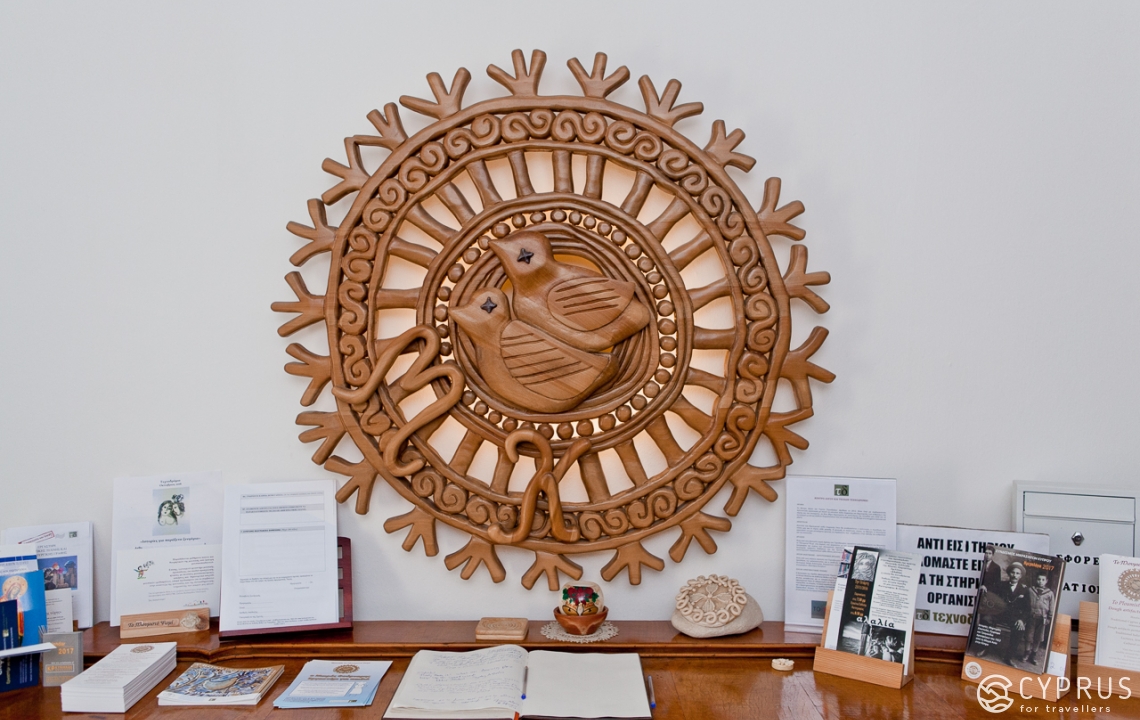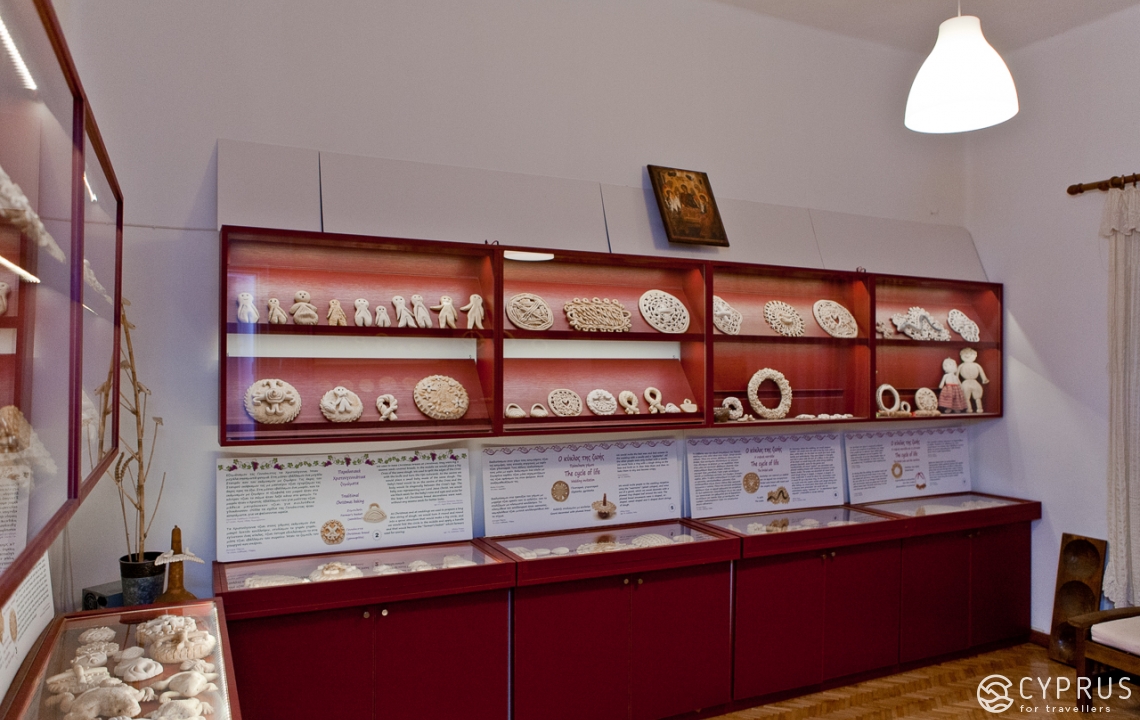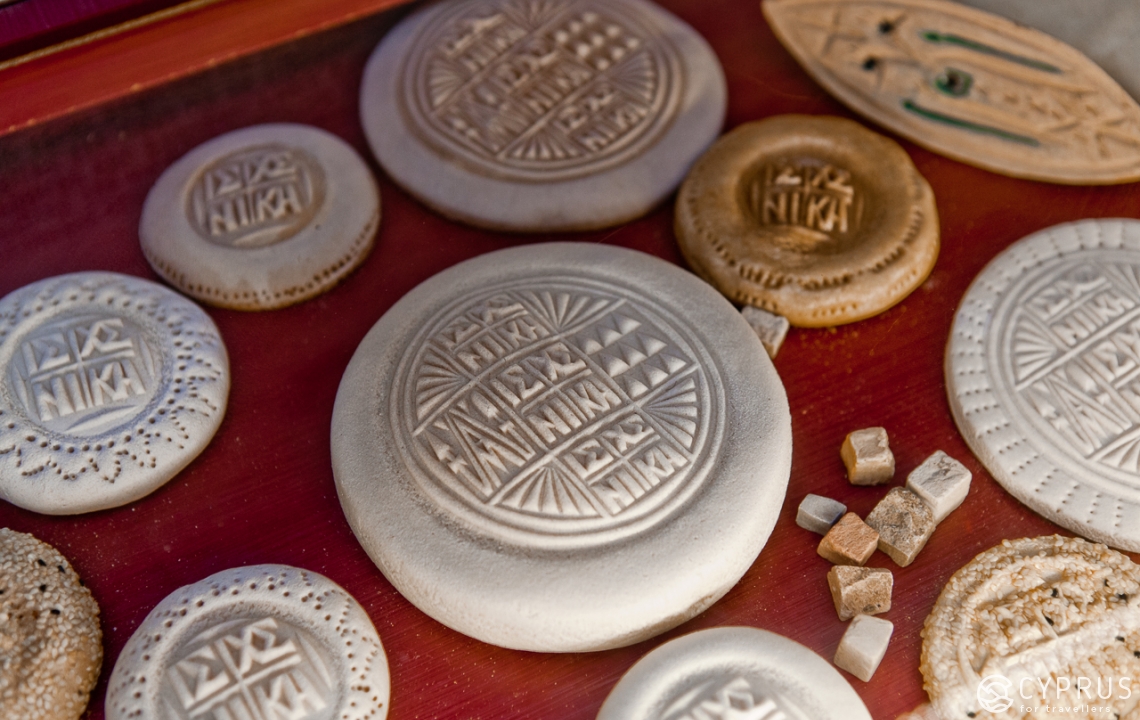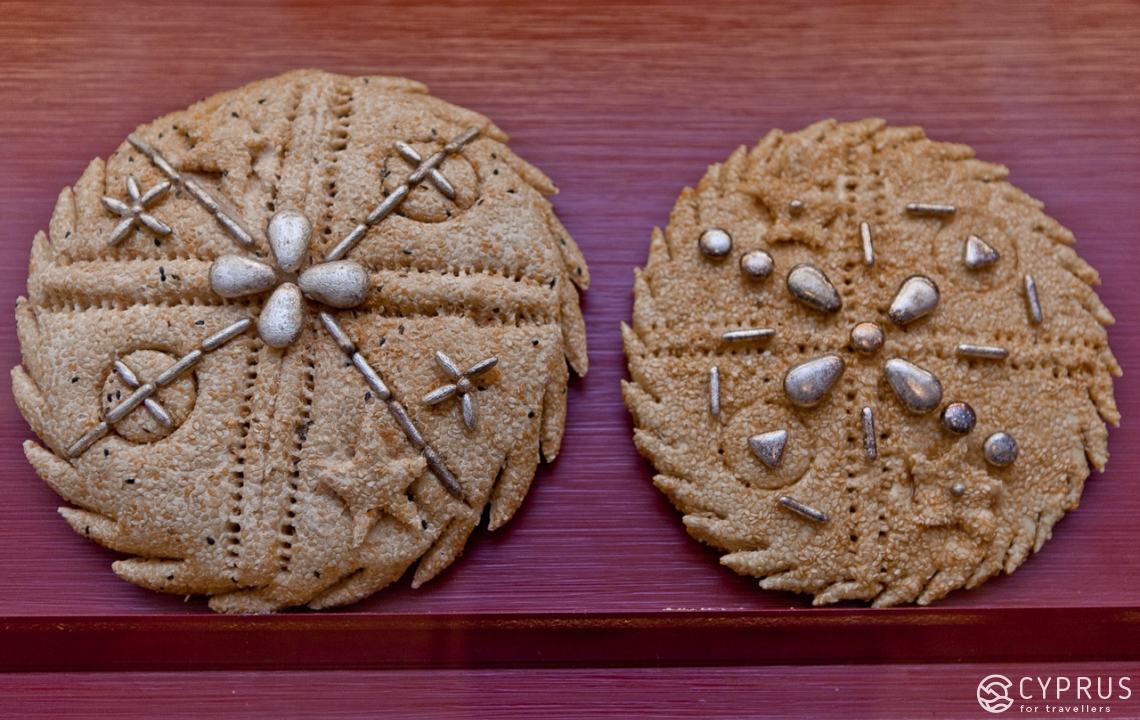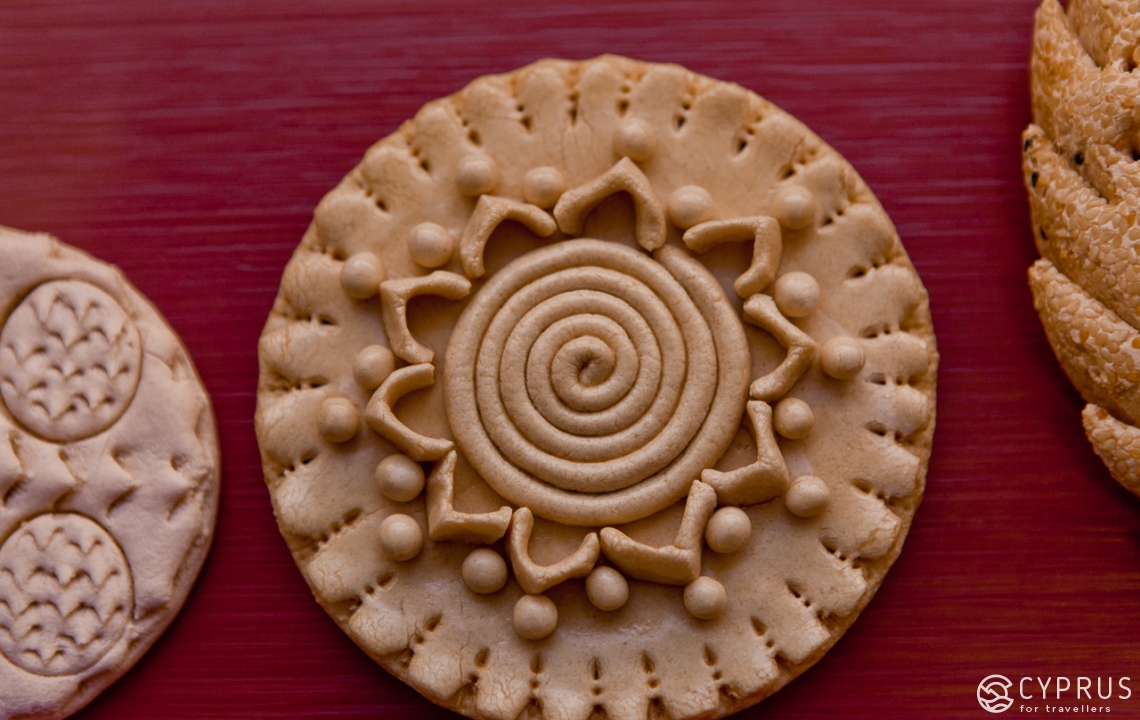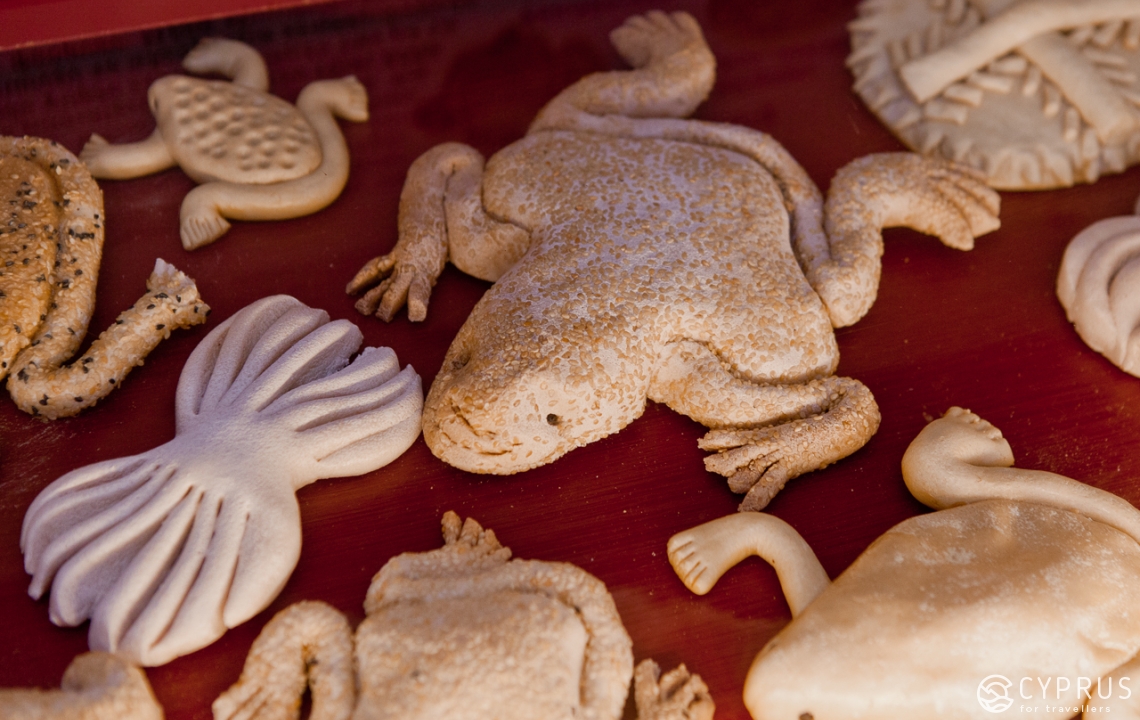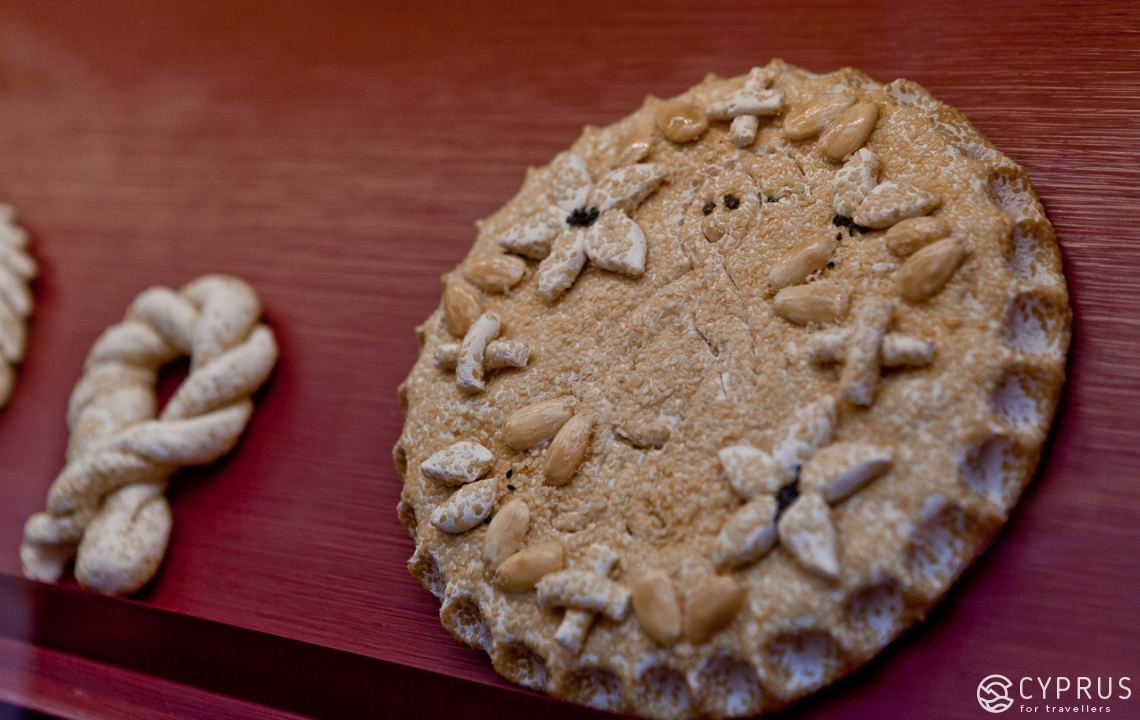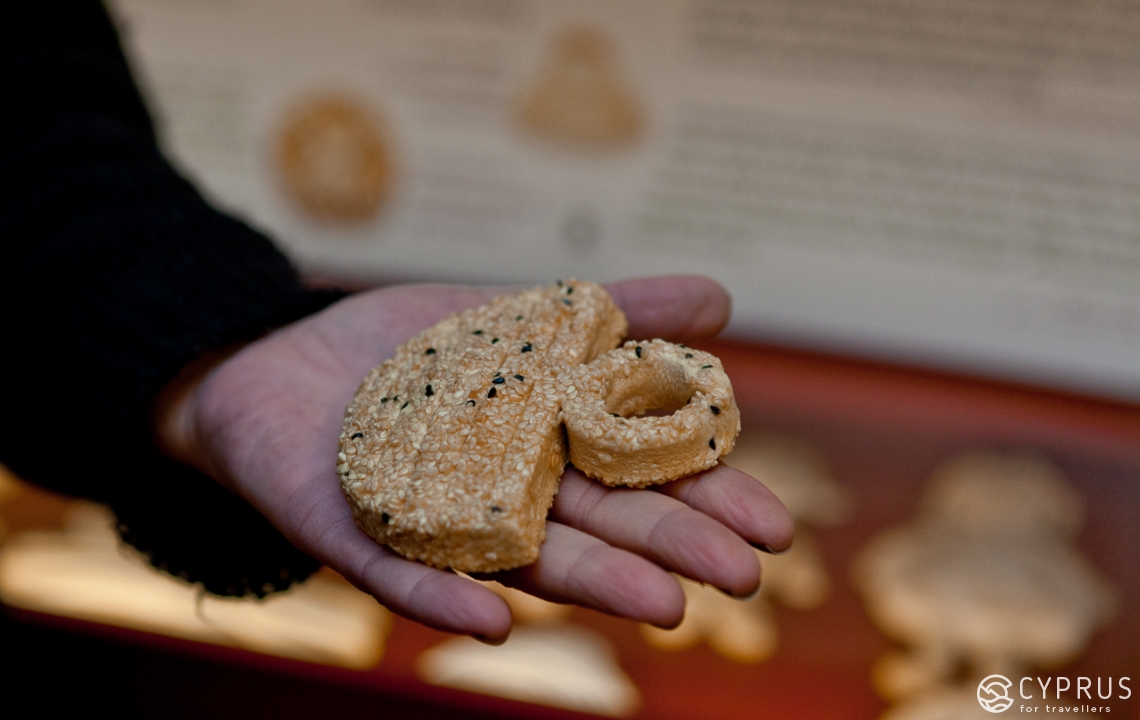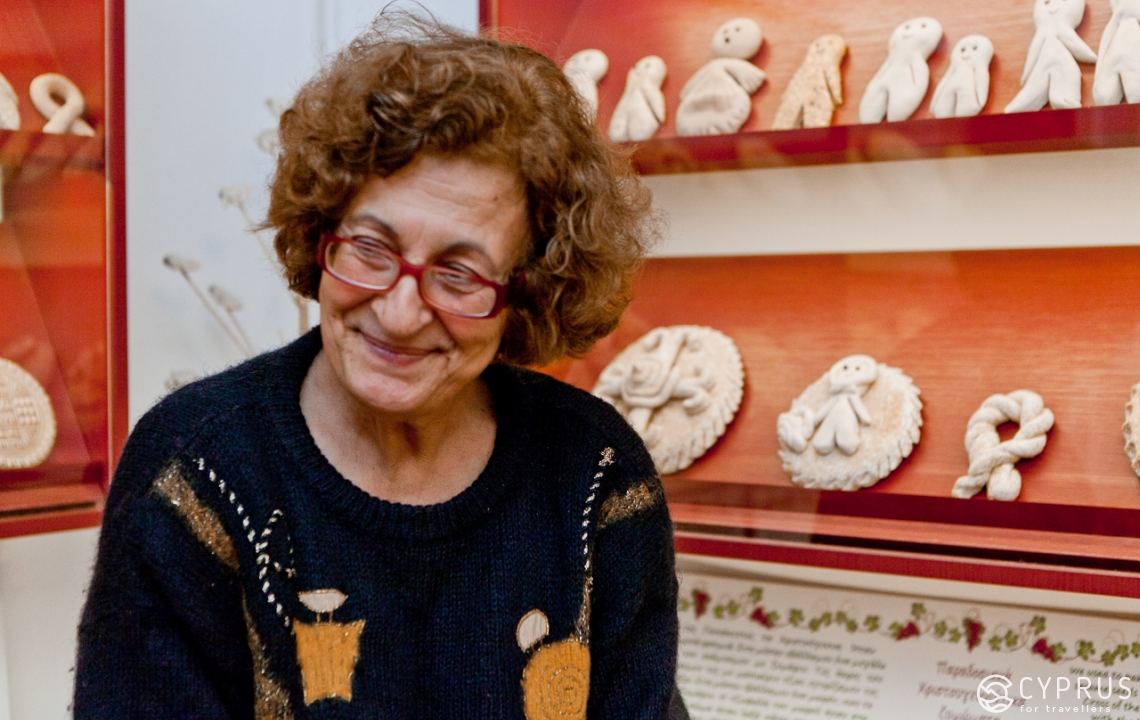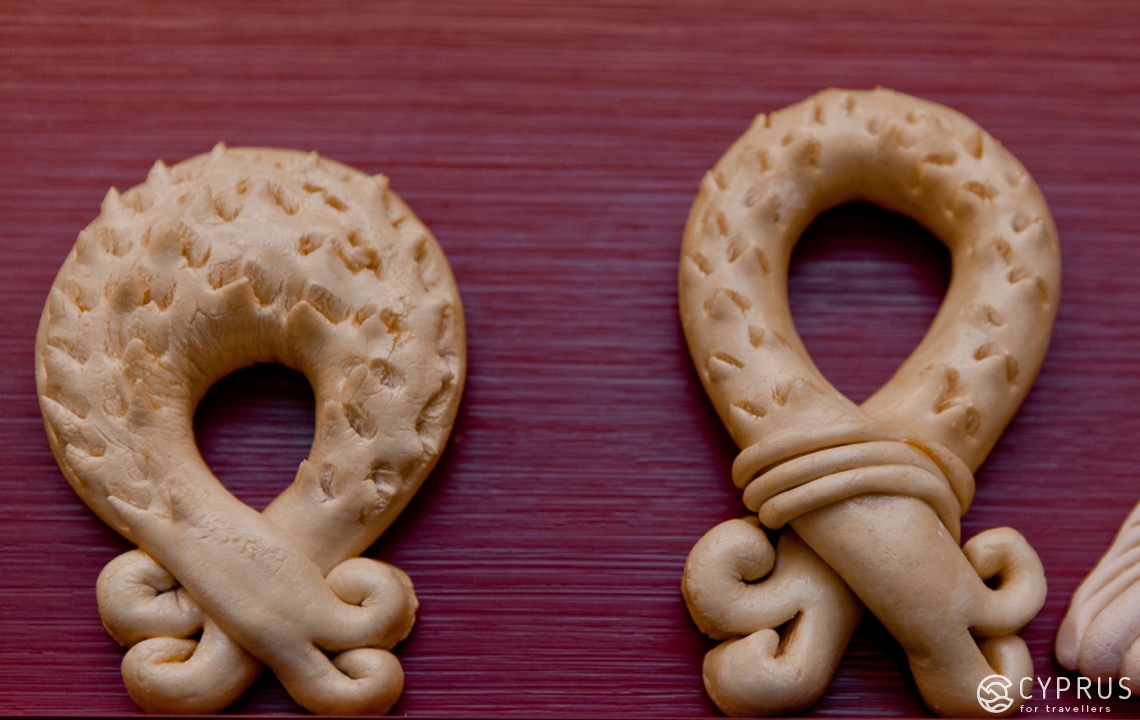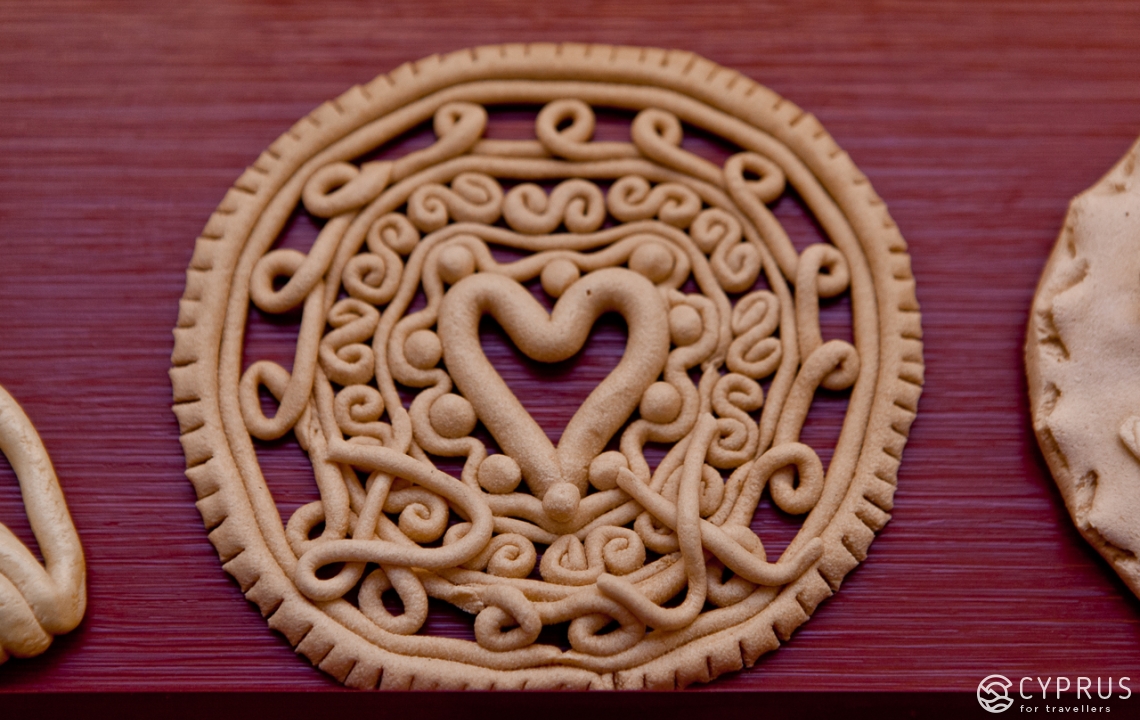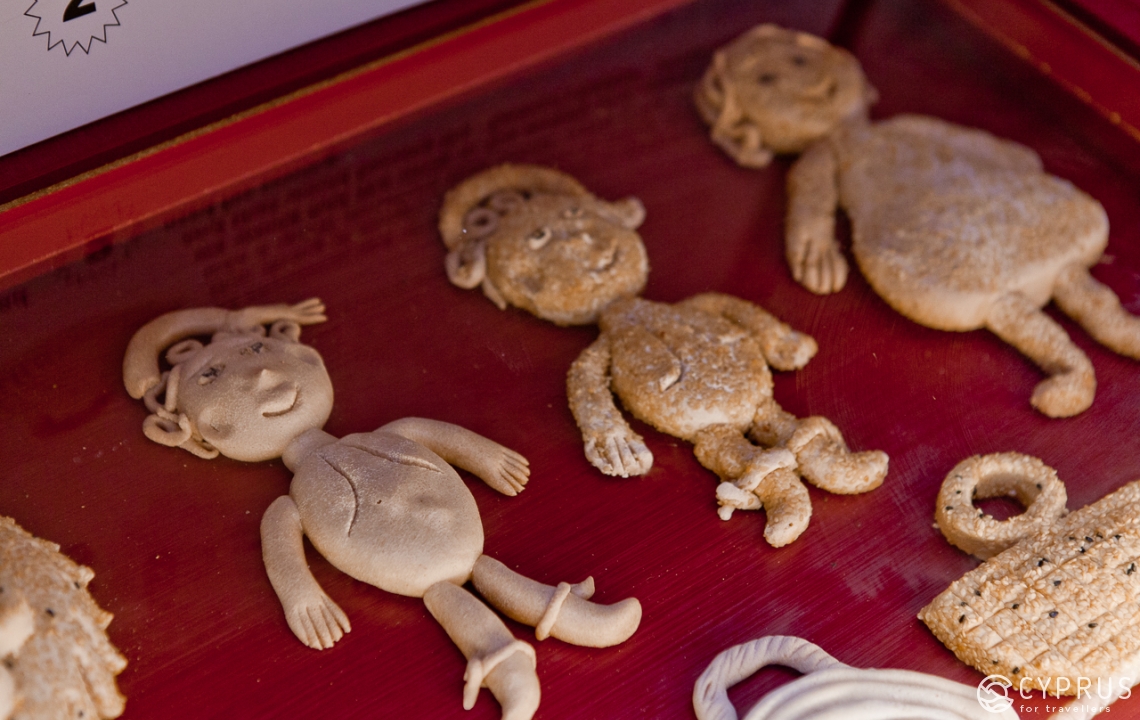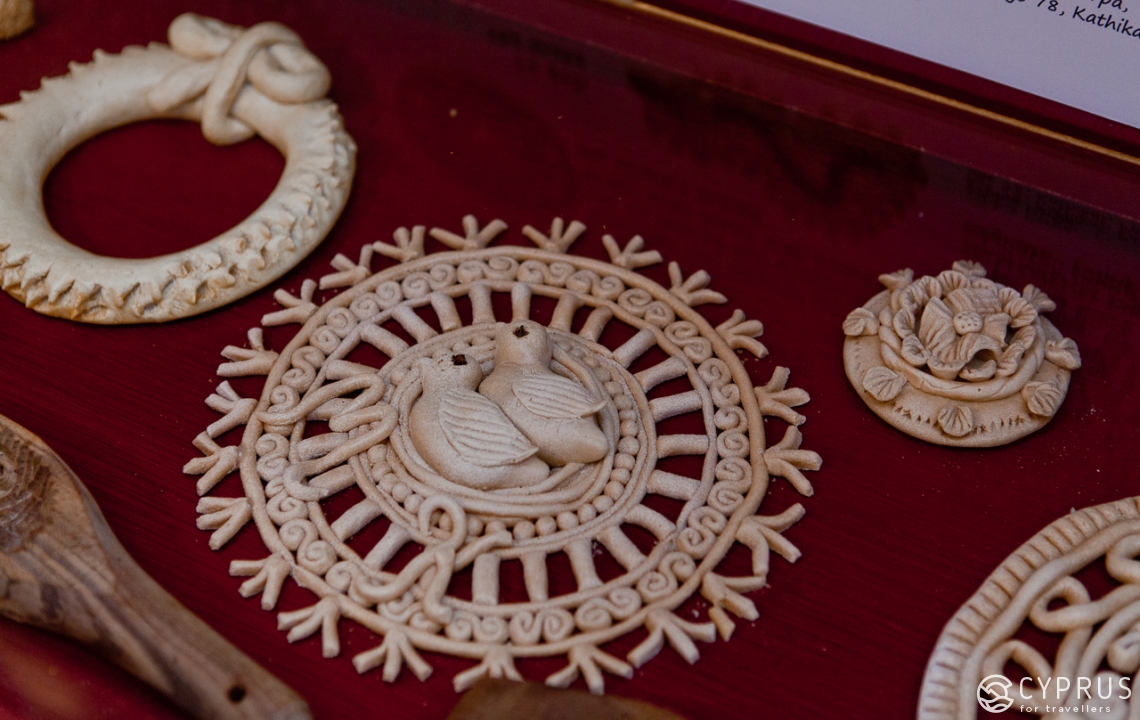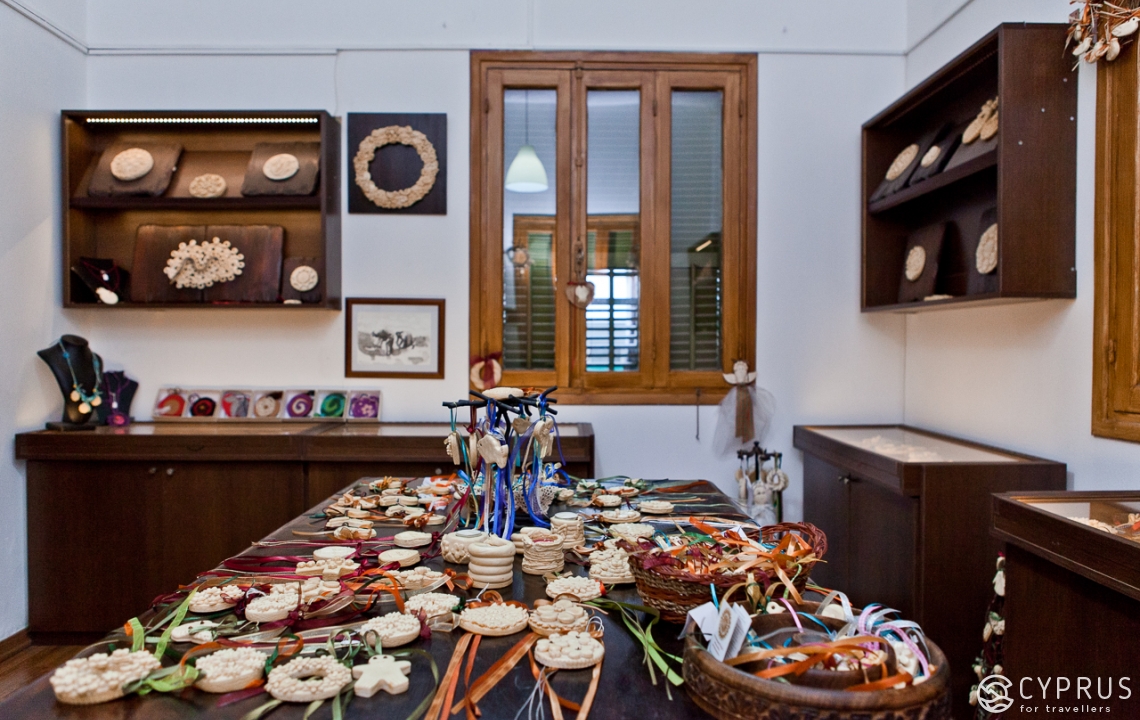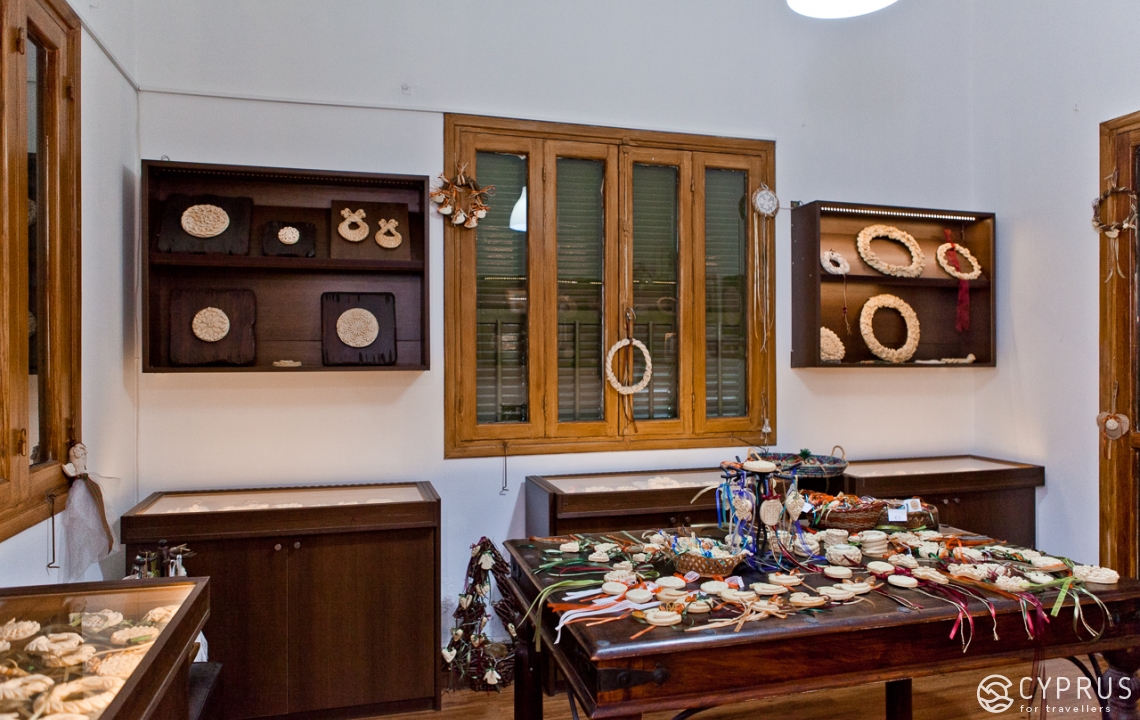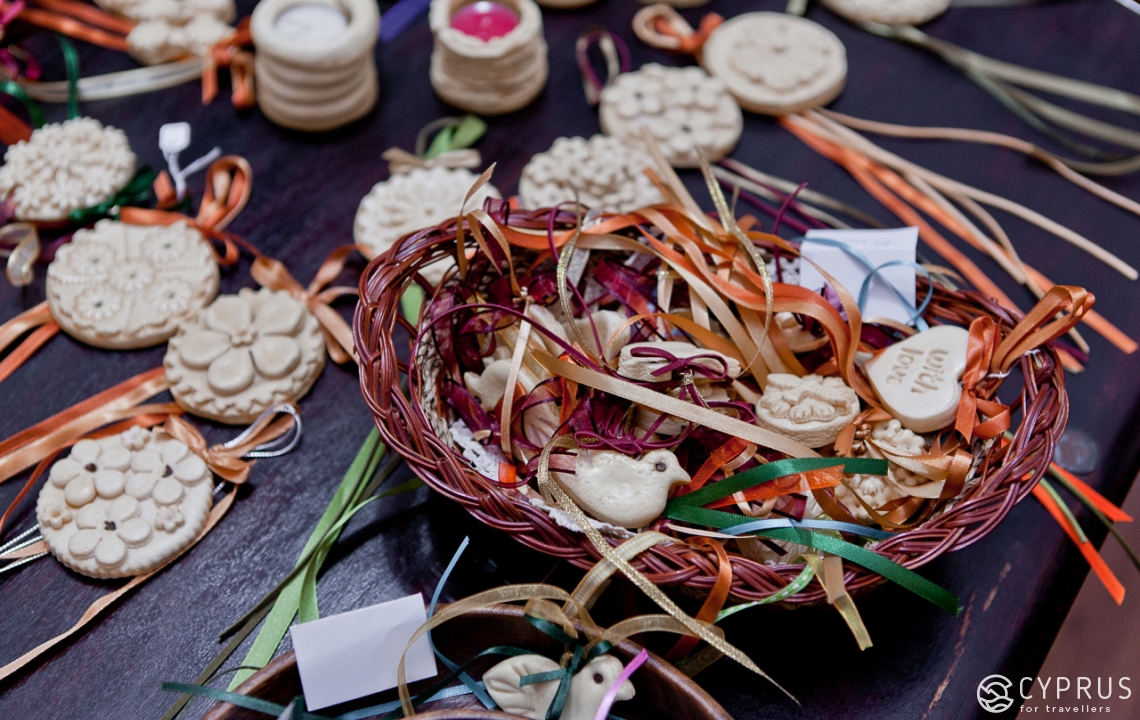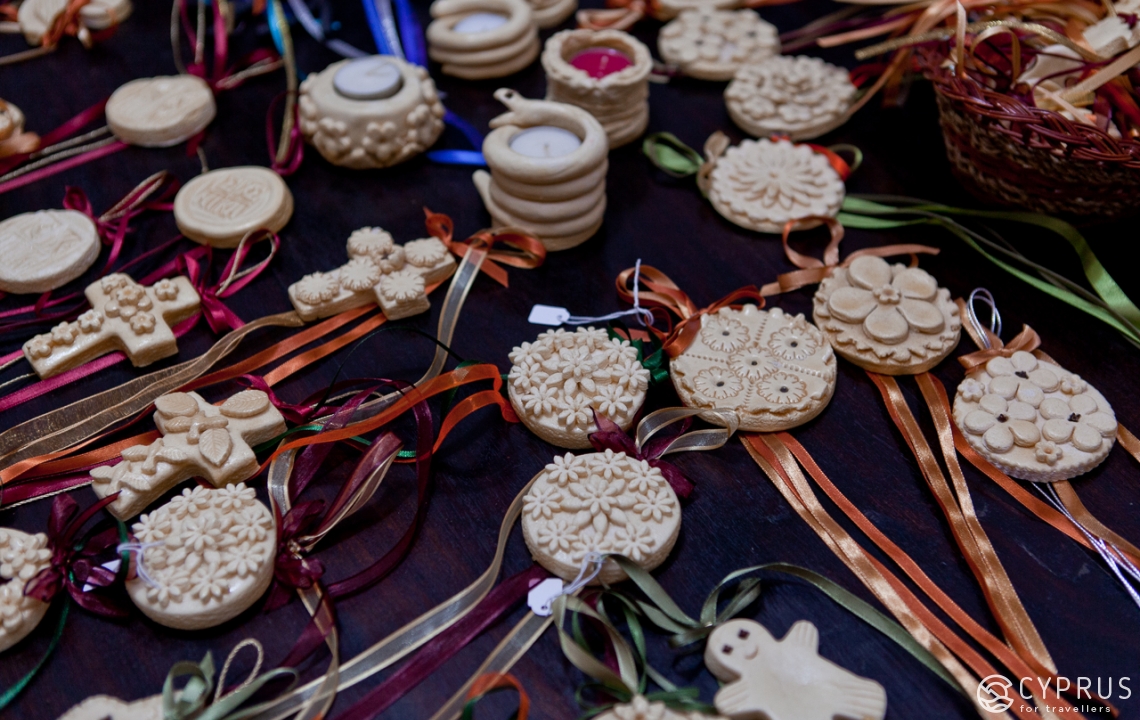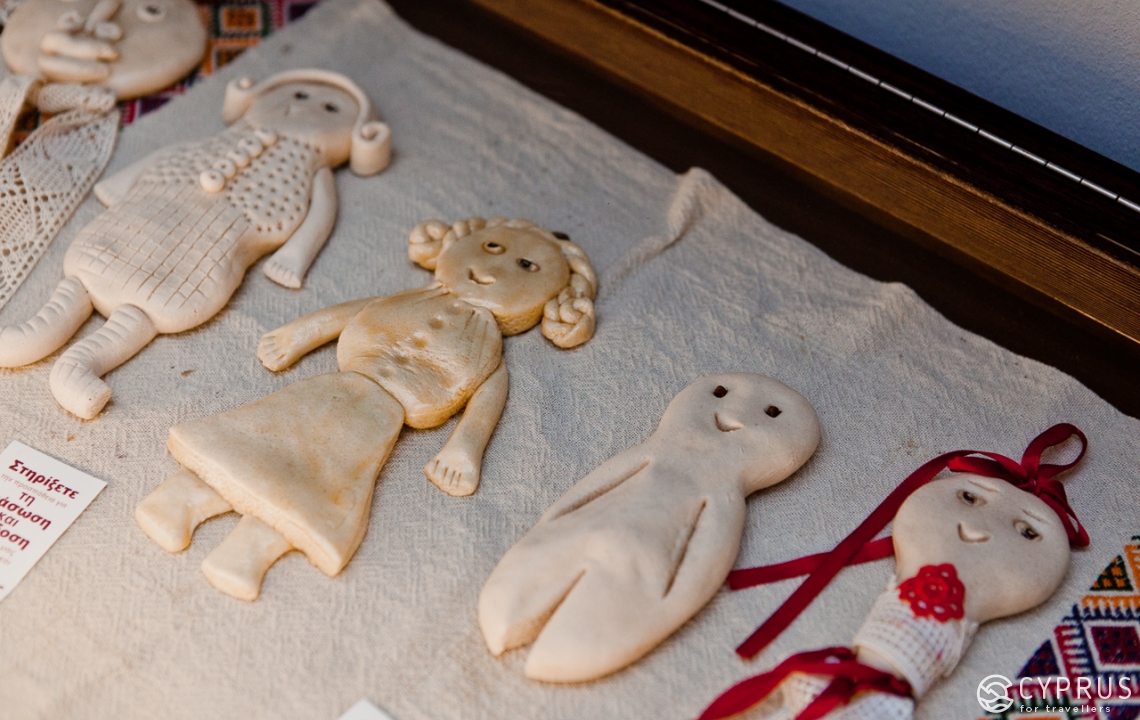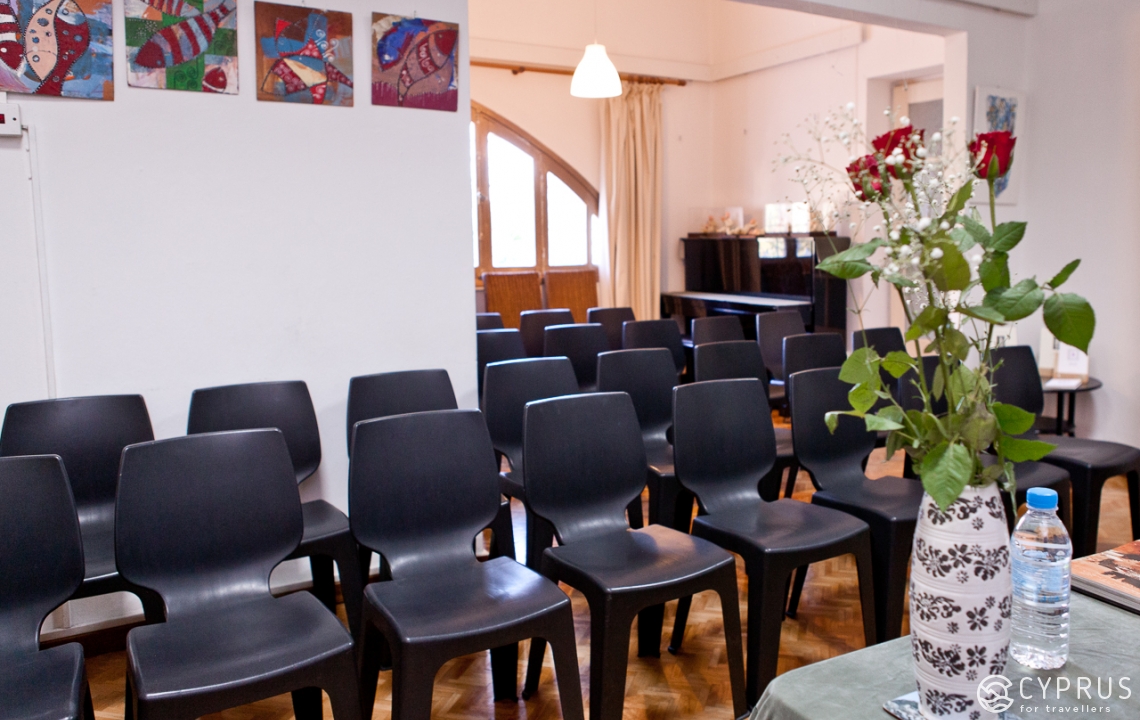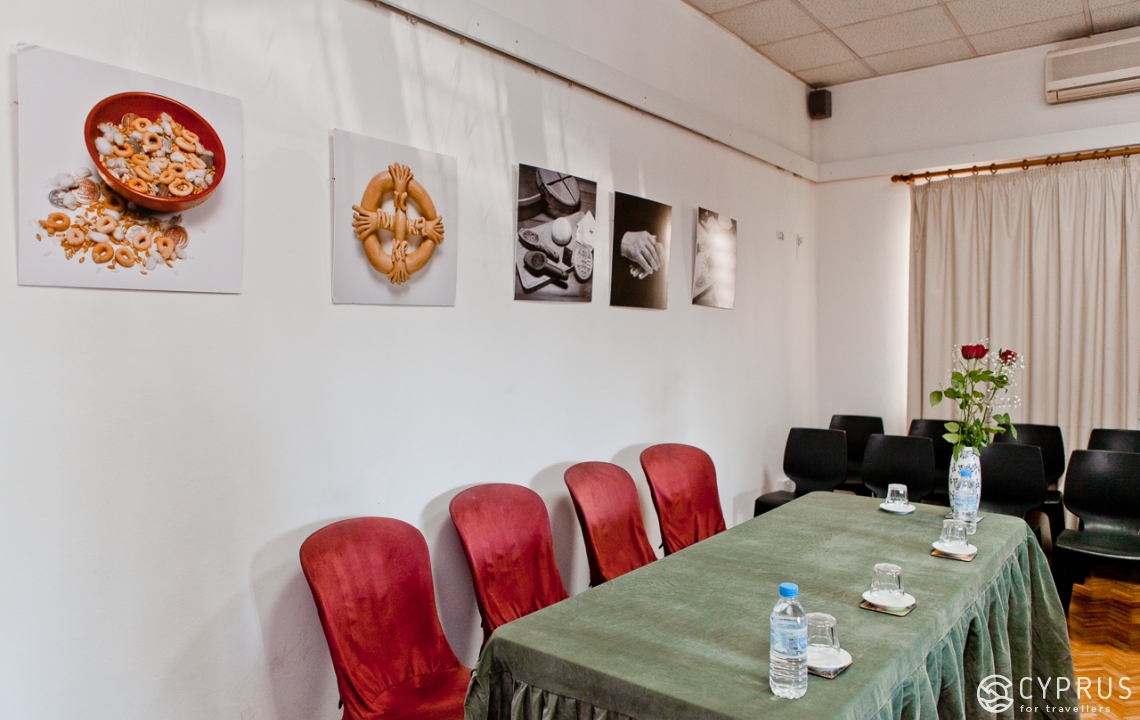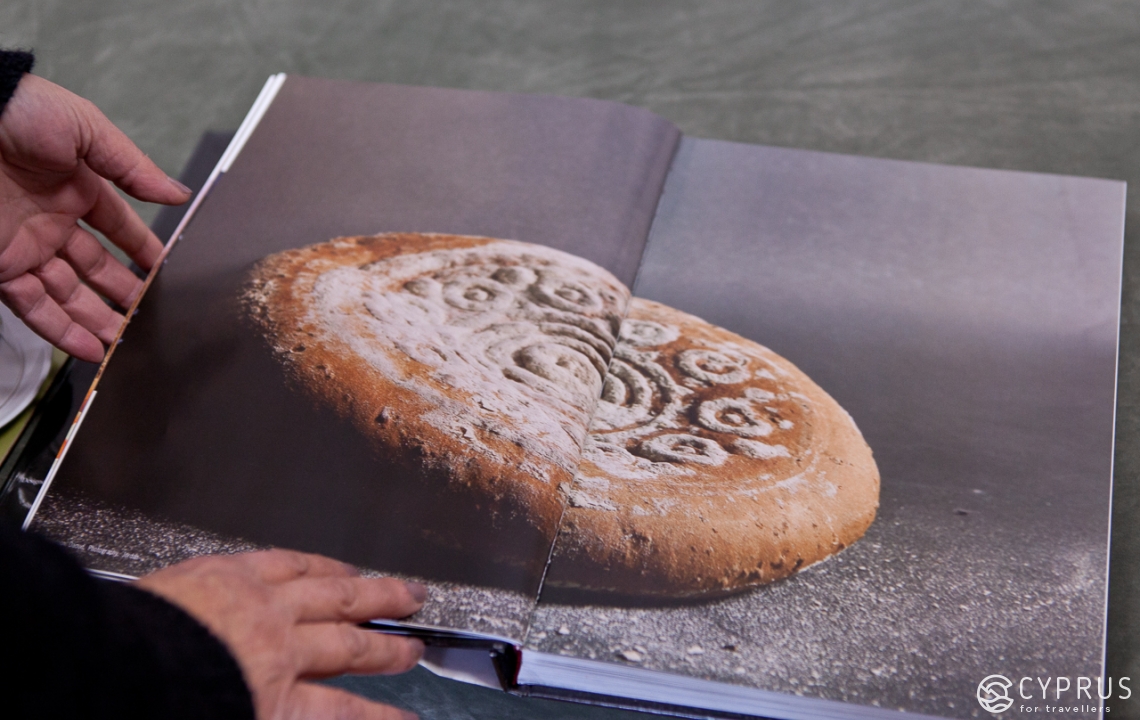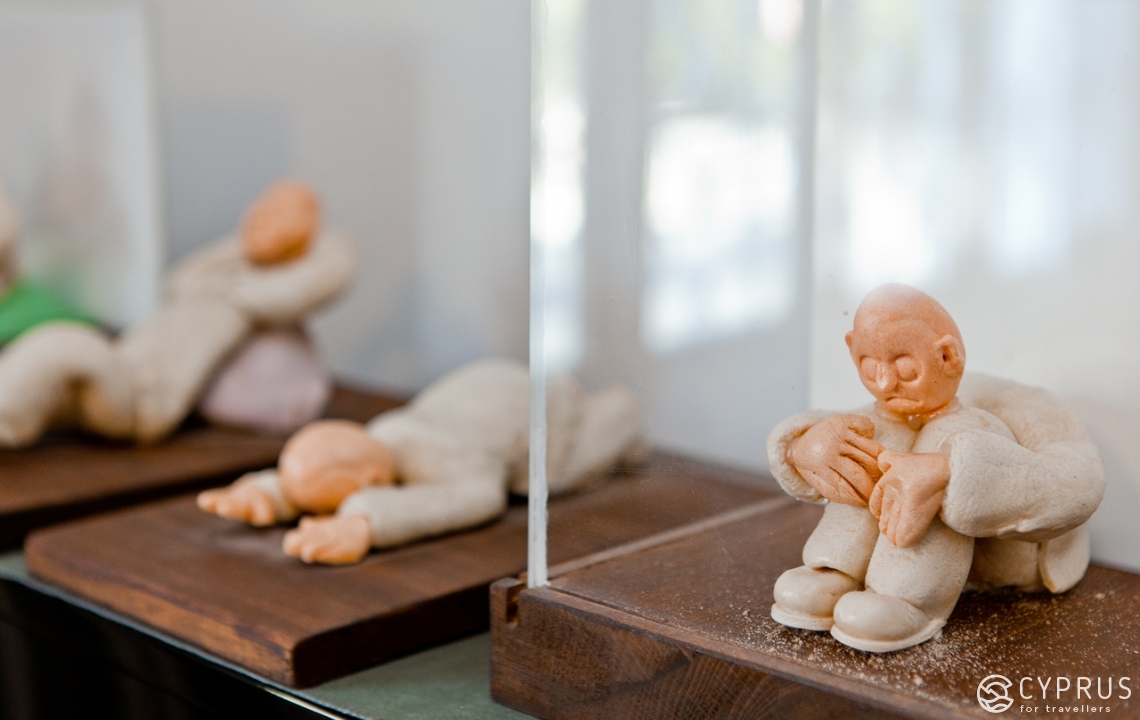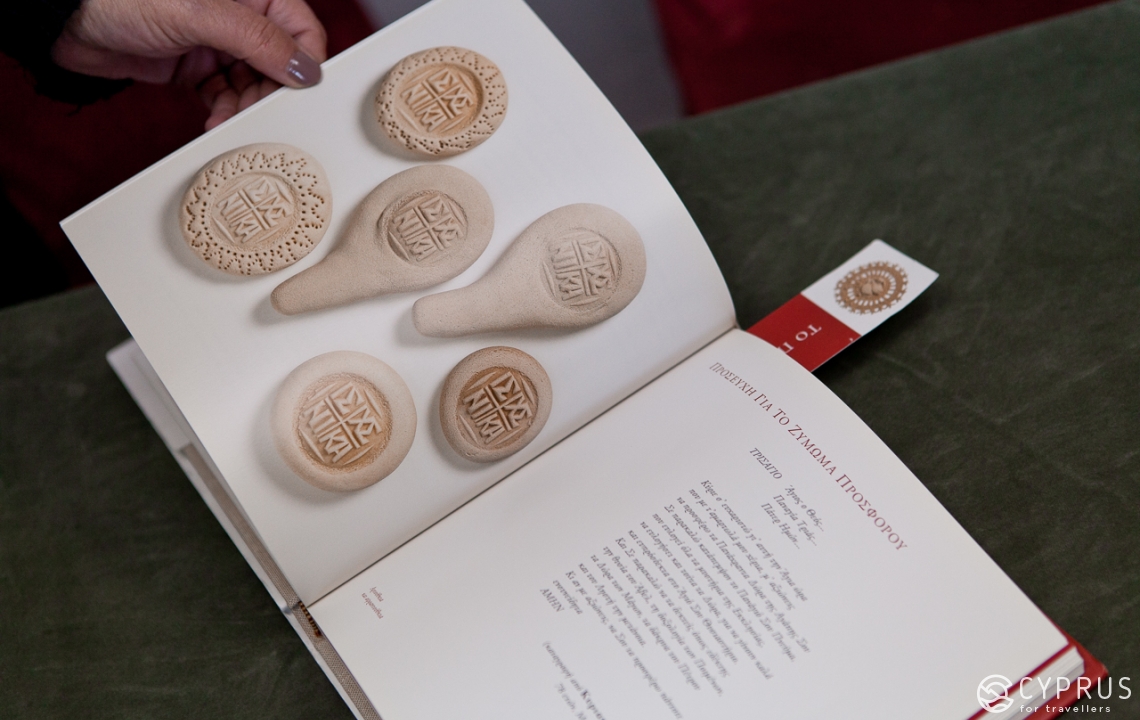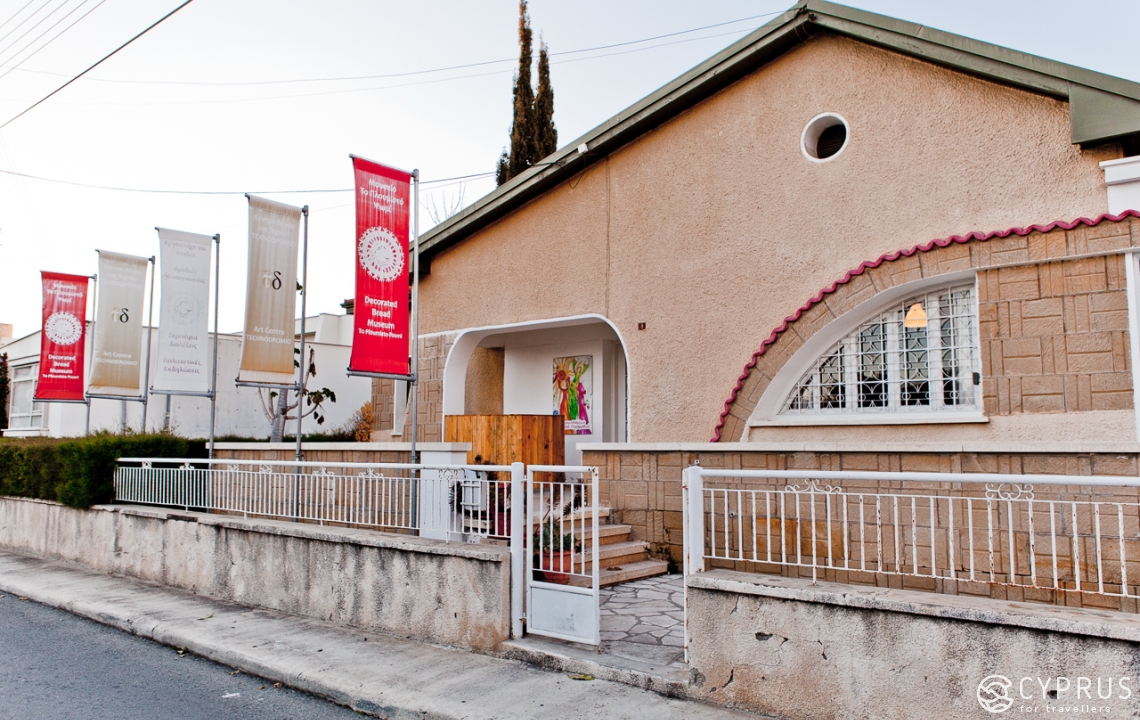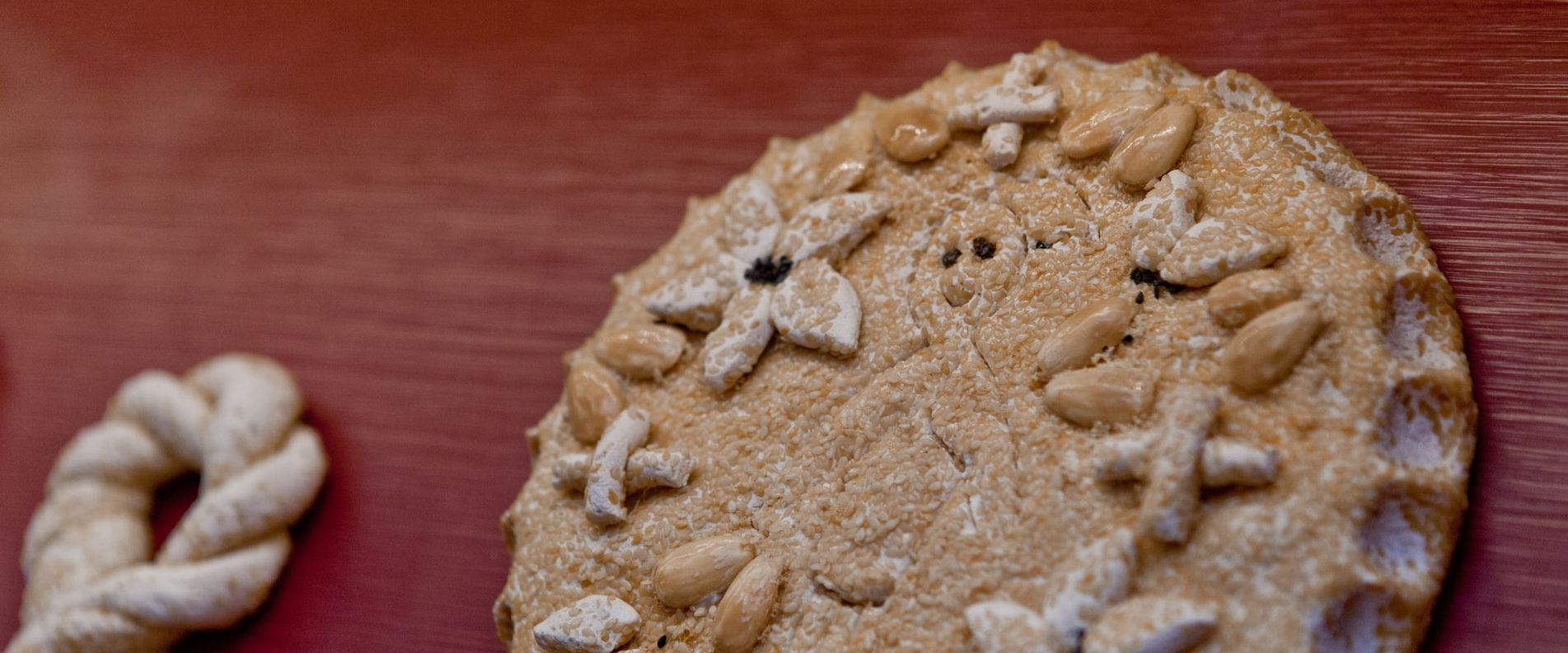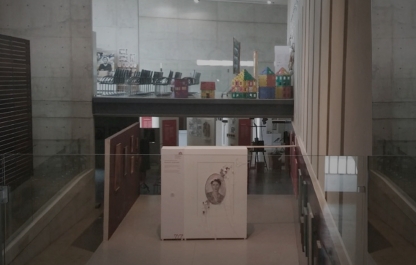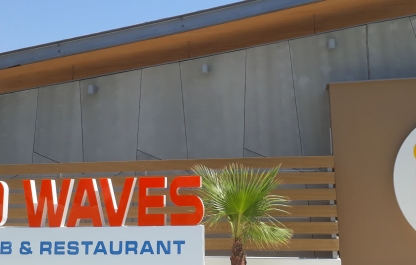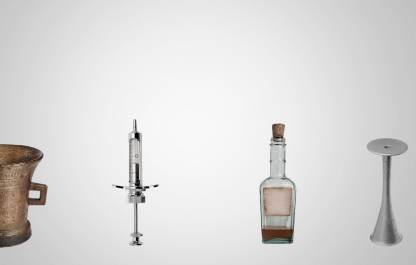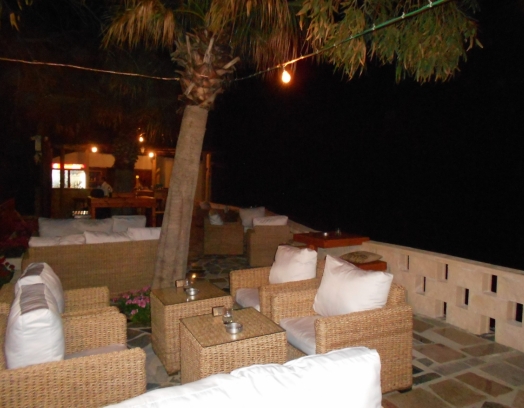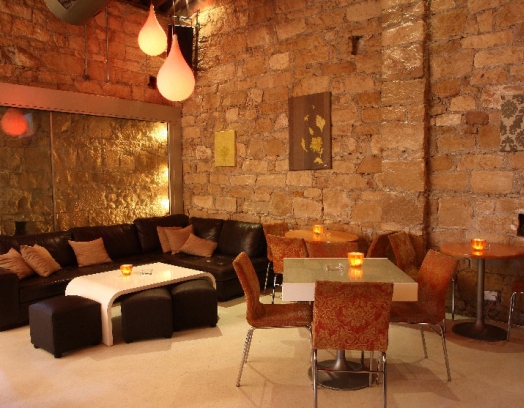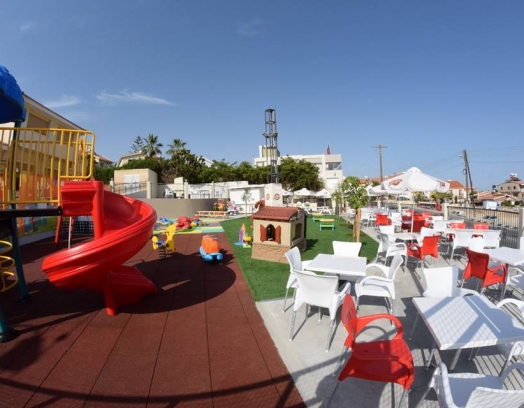«To Ploumisto Psomi» is a museum dedicated to holiday bread, whose collection includes replicas of all types of bread baked in Cyprus for special occasions and holidays. Its permanent exhibition invites you to explore the history of bread and the culture of consumption connected with it. The exhibition also includes a wide variety of centuries-old accessories used for bread decoration.
Besides learning about different baking and decorating methods, you can also try baking something yourself here.
The museum is housed inside a private two-story home. The main exhibition is located inside two relatively small rooms and features all types of bread ever baked on the island for different occasions. There is a souvenir kiosk and a conference hall (former lobby) used for different cultural events, such as literary readings, concerts, seminars and other meetings. But let’s start from the beginning.
The museum is only 7 years old. It is the first museum of its kind in Cyprus (its collection includes approximately 600 objects). The founder of the museum, Ms. Dorita Voskaridou, is a writer and researcher. In 2016 during a festival in Greece, she received an award from UNESCO for preserving the folklore and heritage of Cyprus.
Inside the museum, close to the main entrance, you will see a carved imitation of a wedding pie featuring two birds making a nest. The same pie, but smaller in size, was baked for one of Dorita’s daughters (the «M&K» stands for Michael and Katerina). The pie has now become the museum’s main symbol.
Ms. Voskaridou has single-handedly baked almost all of the bread at the museum using centuries-old recipes. She talked to us about the history of this unusual place.
«I once wrote and published a book about bread and the traditions surrounding it».
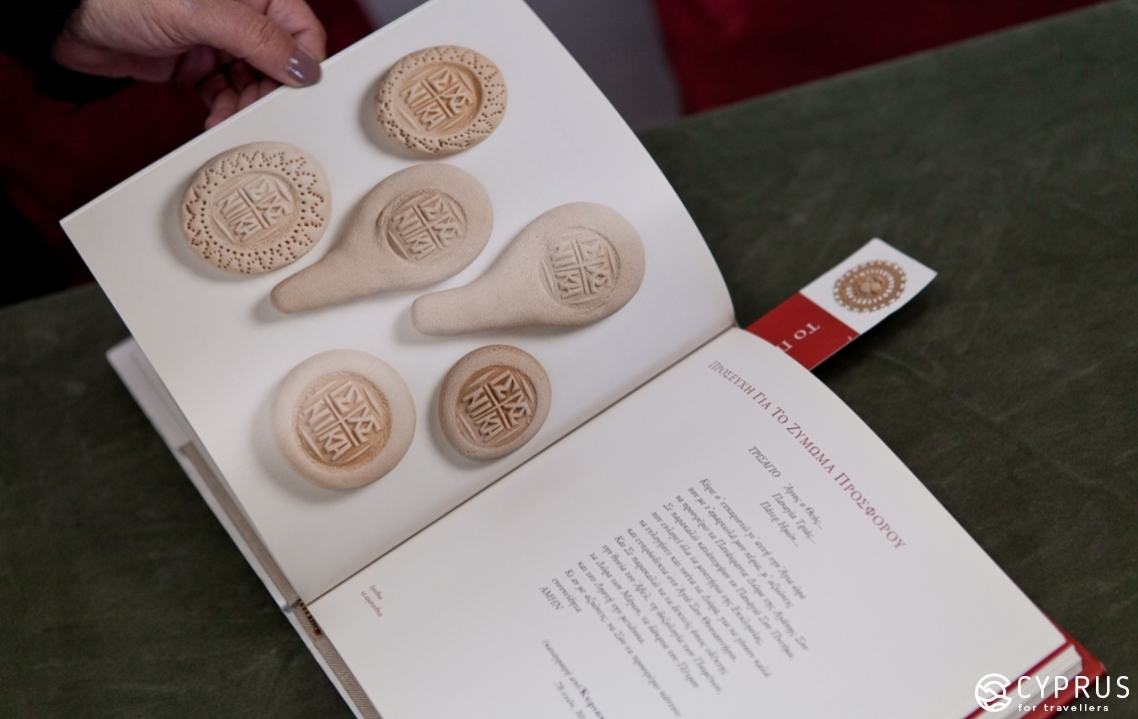
«And then an idea occurred to me that I should organize a permanent exhibition and hold events for adults, children and tourists, who are interested in this subject. Now we have a place where we can talk about the history, baking traditions, recipes, decorating techniques and the culture of consumption associated with bread».
«I always keep some dough around in case our visitors want to bake something. Our baking classes take place in the kitchen, where we learn to decorate and understand the meaning of each decorative pattern. We then put our bread inside a traditional oven located outside. Once the baking process is finished, we have a group lunch, where visitors get to taste traditional Cypriot bread.
Not so long ago we hosted a group of Italians. It was their 3rd time at our museum! We have visitors from the US (most of whom are university professors or researchers). We have a group of British tourists currently baking in our kitchen. Thanks to this place, people from around the world can explore the culture of Cypriot bread».
— How was the museum founded?
— I am actually a professional dentist. However, for many years I’ve been writing about the history and traditions of Cyprus. I find it all very fascinating. 17 years ago I started hosting a radio talk show (and continue to do it), where we talk about our culture in general and Cypriots in particular.
When I sat down to write a book about bread, I started receiving phone calls from the elderly Cypriots, saying «Dorita, I want to tell you about the way we used to bake bread in my village». This made the book writing process a lot easier.
The museum became the next step — it was my daughters’ idea (one of them is a music historian and the other one specializes in theater). Together we created a multi-disciplinary educational platform for children, which also incorporates music and theater.
As part of our museum we also have a working arts center, known as «Tekhnodromio», that one of my daughters runs. We hold poetry readings and concerts in the main hall. We came up with and held the first festival of storytelling. And today we have an actual school of storytelling, where we write stories about antiquity. We also have a group of poets. We hold exhibitions that feature works by international artists. For example, we recently held an exhibition of works by a Jordanian artist, during which we also presented a book that we wrote together with her.
The photographs in the book depict many types of bread from around the world, including Cyprus and Jordan. Readers will find recipes that include ingredients like coffee, flowers and other exotic items.
— So Ms Dorita, which bread is the best?
I think the best bread is the one that is made using a combination of different types of flour as well as grains and cereal (like oats). The village flour produced in Paphos is the best! I buy it every week on the market. The family that sells it makes strictly organic food. The wife also bakes bread and it is just incredible! Her bread stays fresh for 12 days — you can check for yourself.
— What about the symbols and patterns used in bread decoration — what do they mean?
— You would have to go back to the villages that baked this bread to know more. For example, Omodos — it is a special place when it comes to bread.
Its wedding bread includes blooming tree branches (with flowers or grapes), or round-shaped braids that symbolize the sun and new life. This type of bread is baked with sesame seeds and then handed out together with rose water as a form of invitation to the wedding.
— What do these little people mean?
— That’s St. Vassilis [in other countries he is also known as Santa Clause — ed.]. This bread was baked for children ahead of Christmas.
— You have different types of animals appear on your bread. Besides the birds, which are a popular wedding symbol, there are also snakes and frogs. Why frogs?
— Frog is another symbol used in wedding rituals. It is a popular element of Cypriot folklore. There is a village legend about a frog that was blessed for giving water to the crucified Christ.
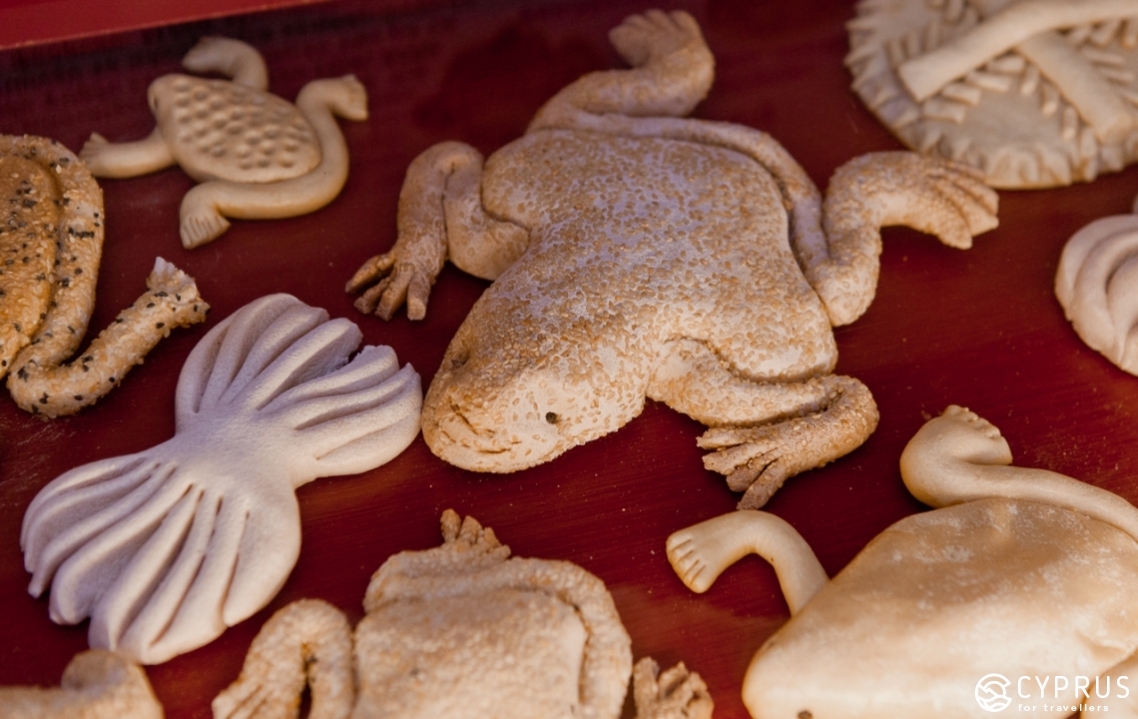
You can also see here that not all bread was meant to be eaten. Some of it was used as part of home décor and to bless or «guard» the house.
— What about the snake-shaped bread?
— A snake is actually a positive symbol in the folklore of Cyprus. You probably know about the nonvenomous «black» snakes. These are whip snakes that protect people’s homes and their harvest from rats and mice. Families kept snake-shaped bread in their home until the birth of their first child. A piece of that bread was given to the child to make sure he or she grew up strong and healthy.
Here is an example of a different pattern: an imitation of a chicken’s foot. Just like eggs and chickens, these feet represent a blessing for the bride. You may also come across the use of bars — they symbolize a wall (protection) around the new family nest.
Here is another example of ornamental bread — it is supposed to be placed on top of a bottleneck, following which it is sprinkled with wine and used during a wedding. [We have noticed an interesting similarity between the use of bread in Cyprus and the ritual of the Eucharist — ed.] This bread was also sometimes placed over a wine gourd and used as a wedding invitation.
Our exhibition also includes «second-day bread». Weddings were usually celebrated on Sundays, which meant that Monday was the second day. This bread was handed out to the bridesmaids. Once there was too much of the «second day bread» (called «pastos» in Greek), people began placing it on the walls of the newlyweds’ room («pastada»). Here we have samples of this bread from Lapitos and Karavas that feature grapes and animals.
Another tradition had a young girl (under 13) bake special bread with milk and honey. Together with rice, cotton and coins this bread was showered over the newlyweds as the priest blessed the couple.
— What did traditional bread taste like? Was it sweet or salty?
— Not too sweet. People usually added honey to represent the couple’s sweet life together. It’s similar to the Russian tradition. Actually, our cultures (Cyprus and Russia) have a lot in common. I have a lot of Russian friends who are also interested in this subject. I would like to start holding events that would be of interest to the Russian tourists as well. Because bread plays just as important a role in your culture as it does in ours. We could, for example, hold a bread festival where we would bake our country’s traditional bread, drink wine, cheese and tell interesting stories.
— That’s a great idea! What time of the year do you get the most visitors?
— I think we get pretty much the same amount of visitors throughout the year, but Christmas time and Easter are busier. And every Wednesday we hold events that are open to the public.
— Does this tradition of baking holiday bread still exist anywhere on the island?
— First of all, in Omodos. Its famous arkatena bread uses a special type of yeast made with the foam produced from chickpea fermentation called Arktis. Arkatena is sold as a bag of crisp bread. It is not exactly holiday bread, but it is very popular among Cypriots. Most of arkatena is produced in Omodos and Koilani (Limassol region). Omodos is actually also famous for decorative bread.
Arkatena also appears in Richter’s research (1913). The name probably comes from the Greek word «ergatis», which means «worker» and was used because it takes many of hours to make this bread. Arkatena was used as a special treat during baptisms and weddings.
Interestingly enough, you can also take soft koulouri, let it cool down and then send it back into the oven for another 5-6 hours until it becomes crispy. This type of arkatena is known as «paximadia».
Both types of arkatena are popular in Cyprus.
Another type of bread that’s famous here comes from Athienou and a Paphos village of Iollu (on the way towards Polis Chrysochous, known for its ancient windmill).
— Is bread making as popular as it was in the past? Do people still bake decorative bread?
— Actually, yes. Bakers still get a lot of requests for decorative bread, although not all of these symbols are being used today. Even I get asked to bake traditional bread for special occasions, such as weddings. In addition to decorating everything by hand, I also started using templates and molds.
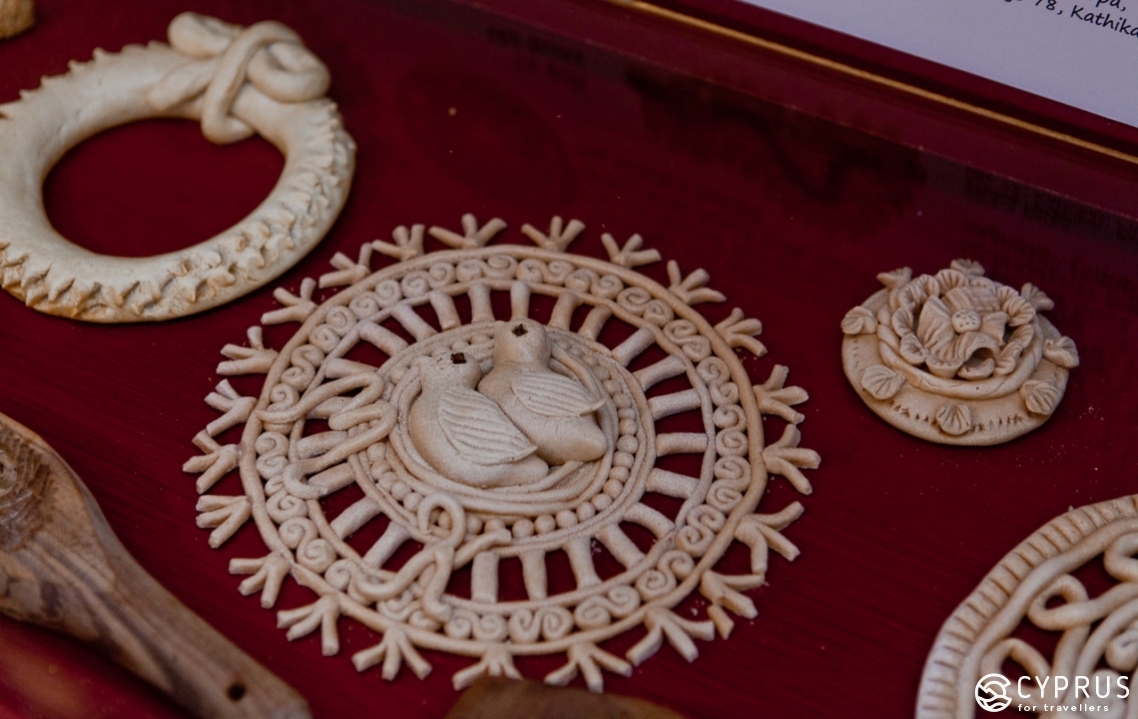
I also use dough to make art objects and souvenirs. They are not to be used as food, obviously, because I soak the dough in a special solution that hardens and preserves it. These objects (you will see them on display here) have a really long «shelf life»: some of them are already 70 years old.
— You know we used to have something similar in Russia: figurines made of salty dough that were used more or less for the same purpose.
— Yes, I’ve heard of it. I also add salt to my dough.
After speaking to the owner of the museum, we move on to explore the exhibition. The first floor features display windowswhose bright red color looks beautiful in contrast to the white dough of the bread. Each object on display comes with an explanatory note in Greek and English that describe its origins and purpose.
The three main types of ritual bread in Cyprus:
Glystarkes — arevery thin, crispy slices of bread. They are generously covered with sesame seeds and usually made with flour and yeast. The bride’s family bakes them as wedding invitations.
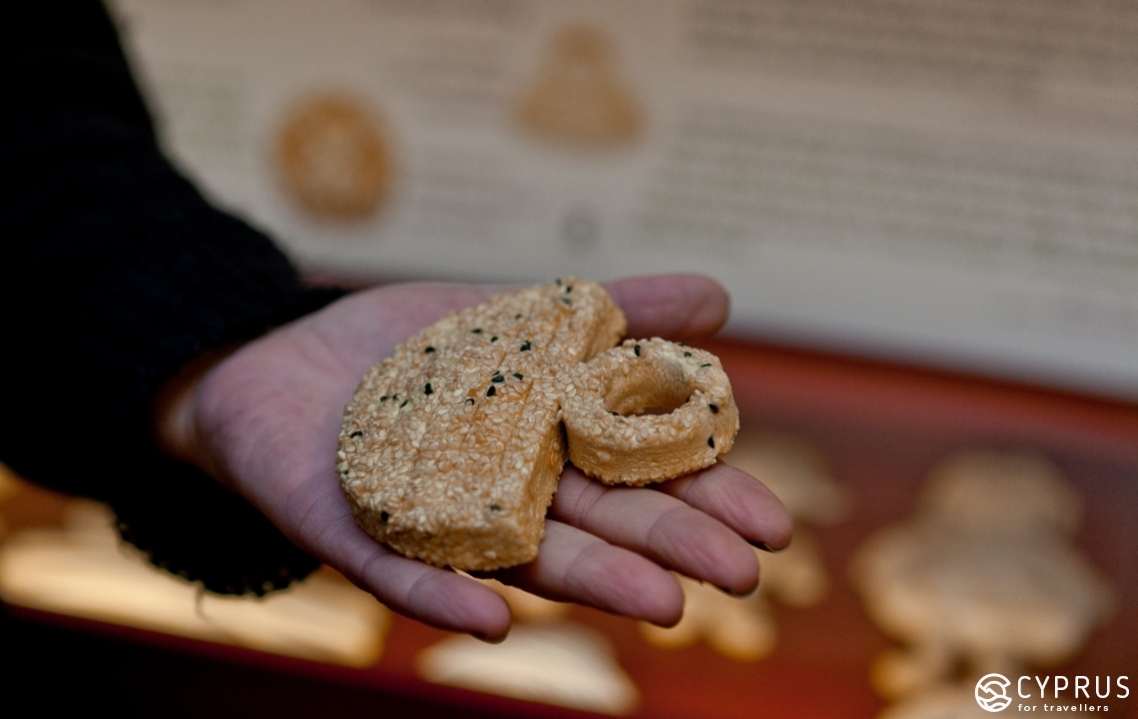
Koulouri — round-shaped bread, typically covered with sesame seeds and sometimes with poppy seeds, flaxseeds and sunflower seeds (this type of bread can also be found in former Ottoman countries and the Middle East). Size and taste will slightly vary.
Prosphora (προσφορά in Greek, which means «offering») — this small size bread is used in Eastern Orthodox religious service during the Eucharist. The original term meant an «offering to the church», but in the Orthodox Christian tradition prosphoron (singular) is the bread offered during the Divine Liturgy. Cypriots also use prosphora at weddings, when the priest offers them to the couple during the ceremony. Prosphora are made of two pieces of dough, which are placed on top of each other, while a special press is used to apply an image on to them.
As you explore the exhibition, you will notice that there are several types of bread used for special occasions: Easter bread (e.g. feature snakes, encircling an egg, etc.), wedding bread («invitation» pies that sometimes feature symbols of female fertility and new life; massive frogs, snakes, and birds with flowers), Christmas bread (small figures of people — both male and female, generously covered with sesame seeds — all symbols of Agios Vassilis), bread used during religious service (prosphora, wafers — used together with wine during communion; for more on this, read our review of the Museum of Wine in Erimi.)
When Ms. Voskaridou joins us again, she points out the particularly old and rare parts of museum collection.
«This bread has a very long history. In pre-Christian times, Greeks used to bake it as they were getting ready to slaughter a goat — this was their offering to the gods. A little later they started feeding this bread to the goat itself. [This fact also comes up in the writings by Xenophon (430-356 BC), who also talked about barley bread being the cheapest type of bread in antique Greece — ed.].
Here is another type of bread, called «zambli». The Cyprus Museum has similar images that are four thousand years old. And we still bake this type of bread in Cyprus!»
We walk further down the museum, past the cafeteria (which is sometimes used for cocktail receptions, but is mainly where Dorita bakes her bread), and then enter the second exhibition hall, which displays items that are for sale. These items feature traditional and even archaic elements that we came across in the «historic» part of the exhibition as well as the more modern decorative elements.
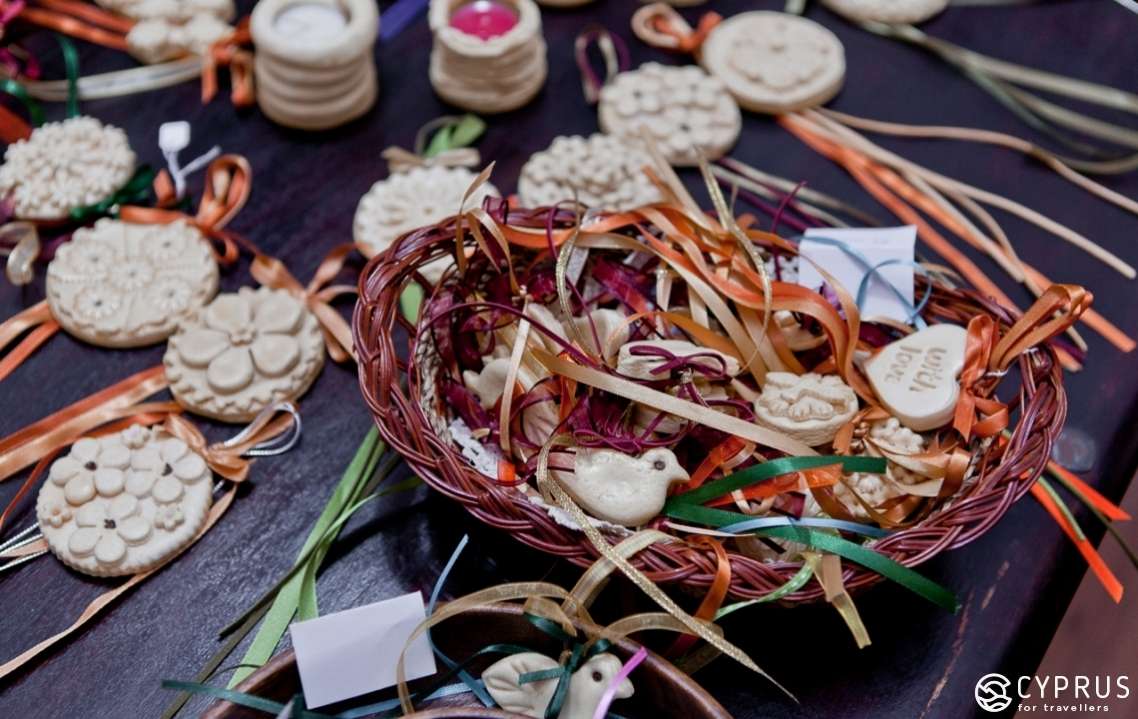
You can purchase something to hang on your wall or door (wreaths, figures of birds, etc), check out the many other souvenirs (e.g. snake-shaped candleholders), or order something to be custom-made (such as invitations to a wedding). The shop also sells dream catchers and leather jewelry.
Not all of the items for sale are made in Cyprus. Some of them (mostly wreaths) come from Crete and Thracia. Prices start around 3-5 euros and up.
Address: Grigori Afxentiou 9, Limassol.
Entrance is free; donations are welcome (this unique museum still doesn’t receive any permanent funding)
Working hours: Monday to Saturday from 09:00-12:30 and 16:00-19:00 except Wednesday and Saturday afternoons.
Please note that if you want to participate in any of the educational programs, you must call in advance and sign up: +357 25 340347, 357 99526772.
See you soon!
Written by Evgeniya Kondakova-Theodorou.
